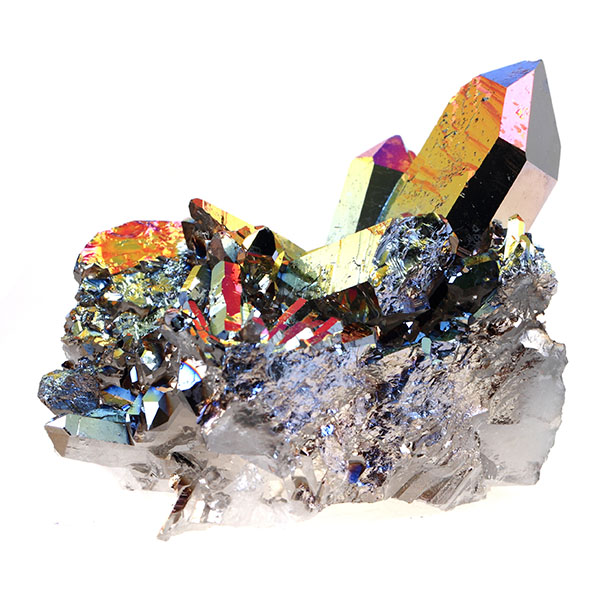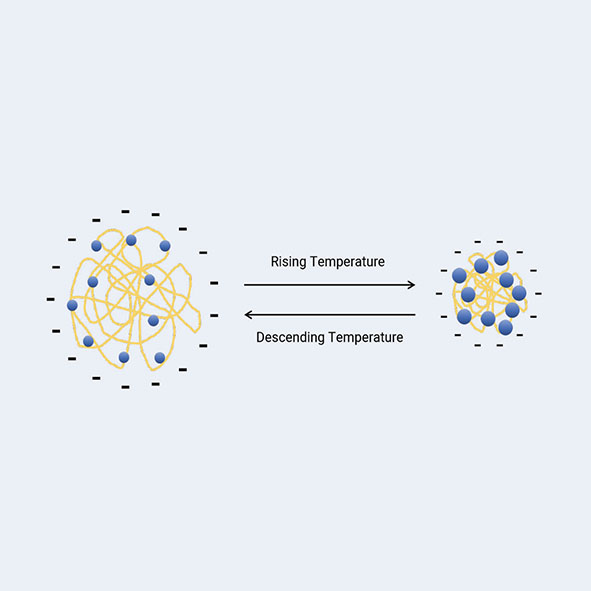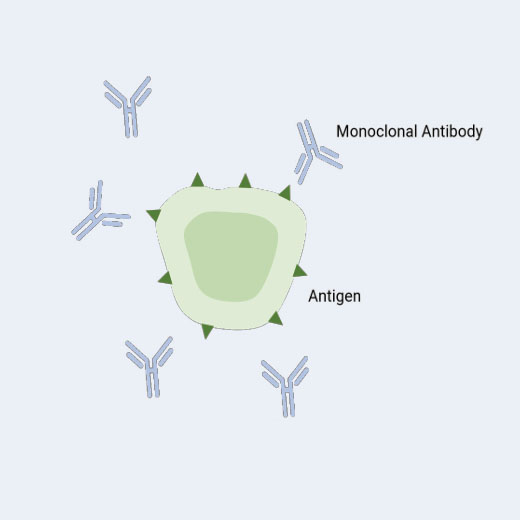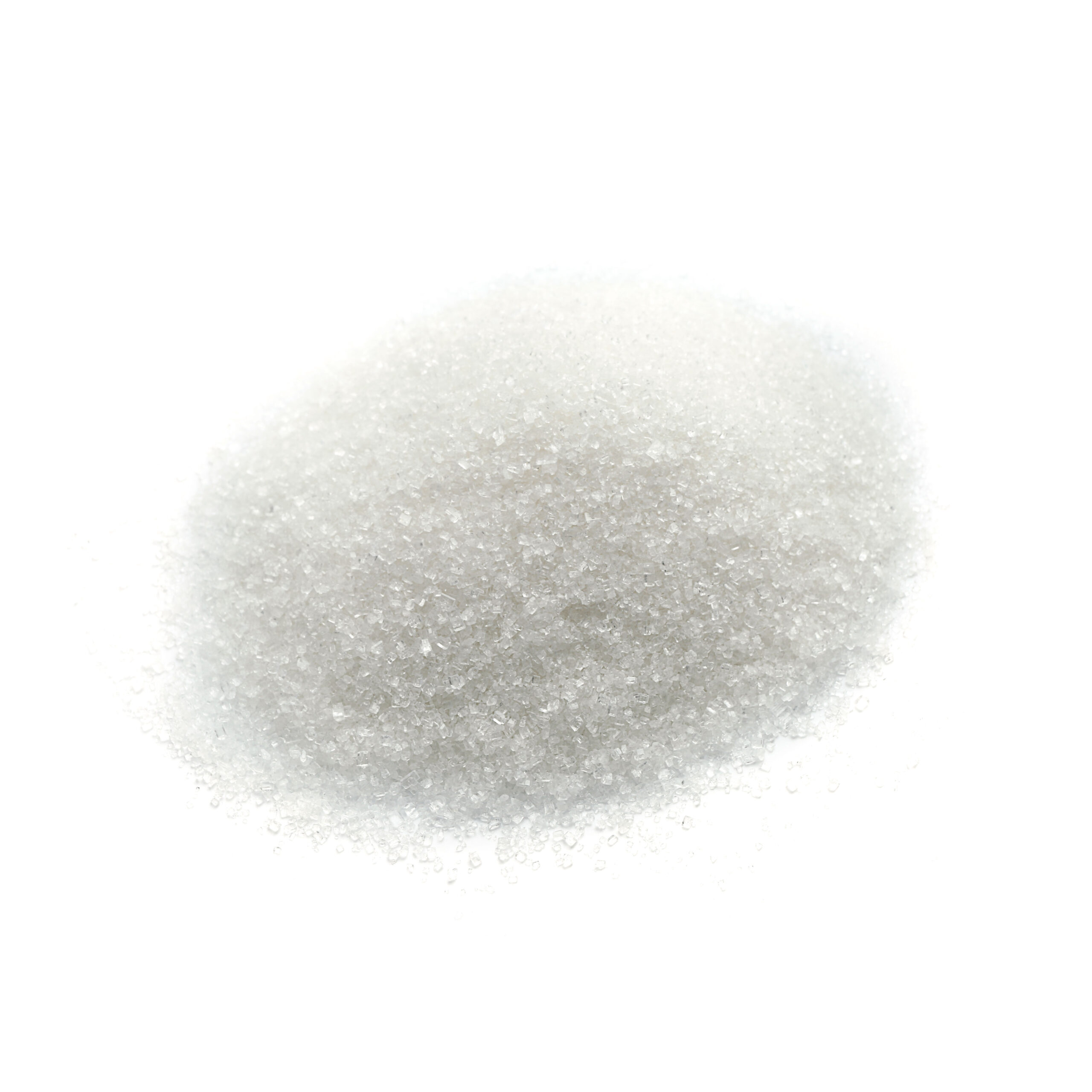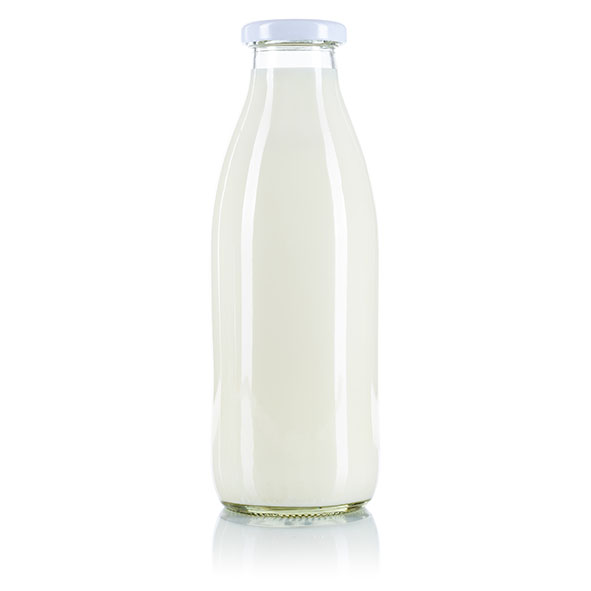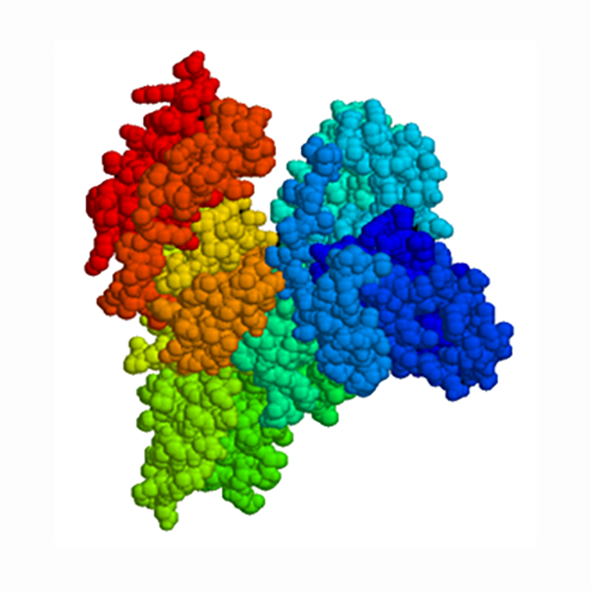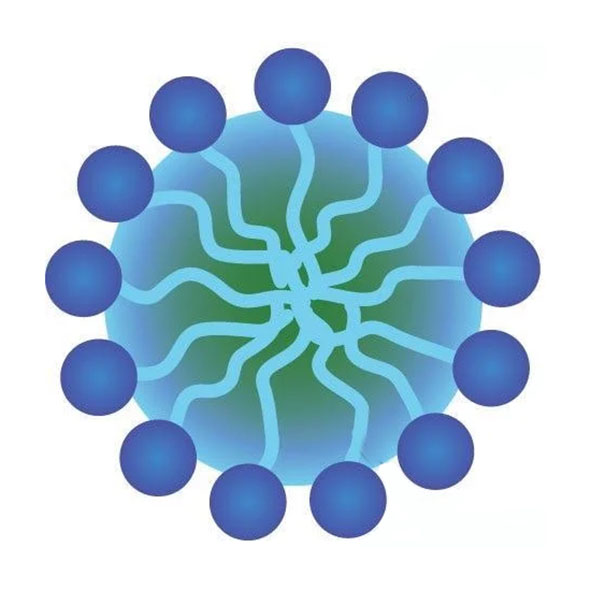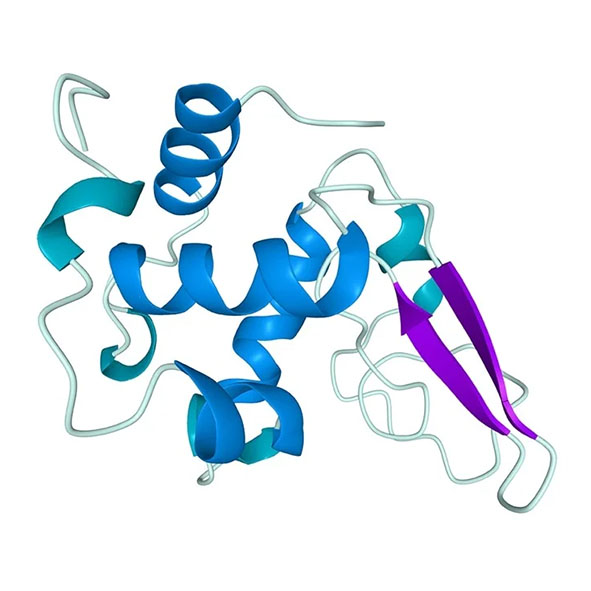Bettersize
BeNano 180 Zeta Pro
Nanoparticle Size and Zeta Potential Analyser
- Expanded measurement range 10 nm – 3,500 µm
- Enhanced PIDS Technology
- Real data down to 10nm
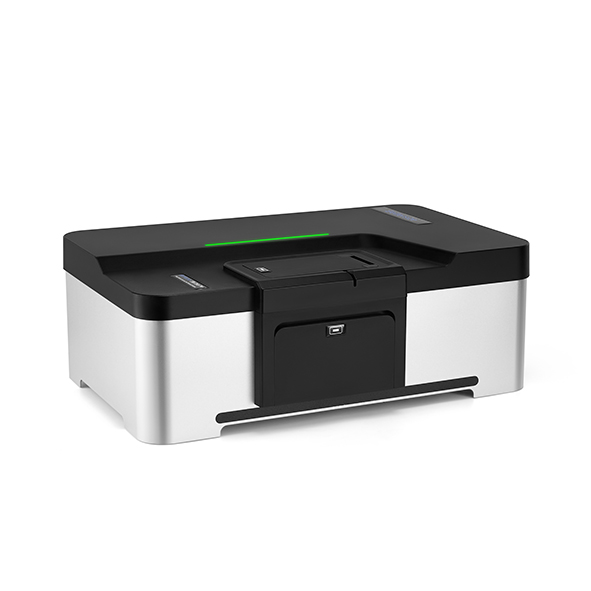
The BeNano Series is the latest generation of nanoparticle size and zeta potential analysers designed by Bettersize Instruments. Dynamic light scattering (DLS), electrophoretic light scattering (ELS), and static light scattering (SLS) are integrated into the system to provide accurate measurements of particle size, zeta potential, and molecular weight. The BeNano Series is widely applied in academic and manufacturing processes of various fields including but not limited to: chemical engineering, pharmaceuticals, food and beverage, inks and pigments, and life science, etc.
Features and Benefits
- Size range: 0.3nm – 15μm
- Minimum sample volume 3μL
- APD (Avalanche Photodiode) detector providing exceptional sensitivity
- Automatic adjustment of laser intensity
- Intelligent algorithm of result evaluation
- DLS backscattering (173°) detection technology
- User-adjustable scattering volume for concentrated samples
- PALS (Phase Analysis Light Scattering) technology
- Programmable temperature control system
- Compliance with 21 CFR Part 11, ISO 22412, ISO 13099
-
Features
1) Unlock Greater Research Potential With BeNano
Advanced ELS Technology: PALS
PALS technology can effectively distingguish and extract the electrophoretic behavior even for sample with weak eletrophoretic mobilities, either close to isoelectrical point or with high salinity environment.Advanced DLS Technology: Backscattering Detection
Backscattering DLS optics can detect much larger scattering volume compared to 90-degree optics. Combined with movable measurement position, backscattering DLS offers much higher sensitivity and high turbidity sample measurement capacity.Temperature Trend Measurement
For thermal sensitive samples, a temperature trend can be performed easily with a programmed SOP. The BeNano can detect the temperature transition point of the size results, which is the aggregation temperature for protein samples.Stable and Durable Optical Bench
The BeNano adopts a 50mW solid-state laser, a singlemode fiber system and a high-performance APD detector, providing stable, wide-ranging, and highly redundant detection capabilities.Research Level Software
The BeNano software can evaluate and process scattered light signals intelligently to improve the signal quality and result stability. Various built-in calculation modes can cover multiple scientific research and application fields.Trace Sample Volume
Measuring trace amount of sample is required for earlystage R&D in pharmaceutical industy and academia. With the capillary sizing cell, only 3 to 5 μL of sample is needed for precise size measurement.

2) Particle Size Measured by Dynamic Light Scattering (DLS)
Dynamic light scattering (DLS), also referred to as photon correlation spectroscopy (PCS) or quasi-elastic light scattering (QELS), is a technique used to measure Brownian motion in a dispersant. It is based on the principle that smaller particles move faster while larger particles move slower. The scattering intensities of the particles are detected by an avalanche photodiode (APD) and then converted into a correlation function using a correlator. From this correlation function, a mathematic algorithm can be applied to obtain the diffusion coefficient (D).

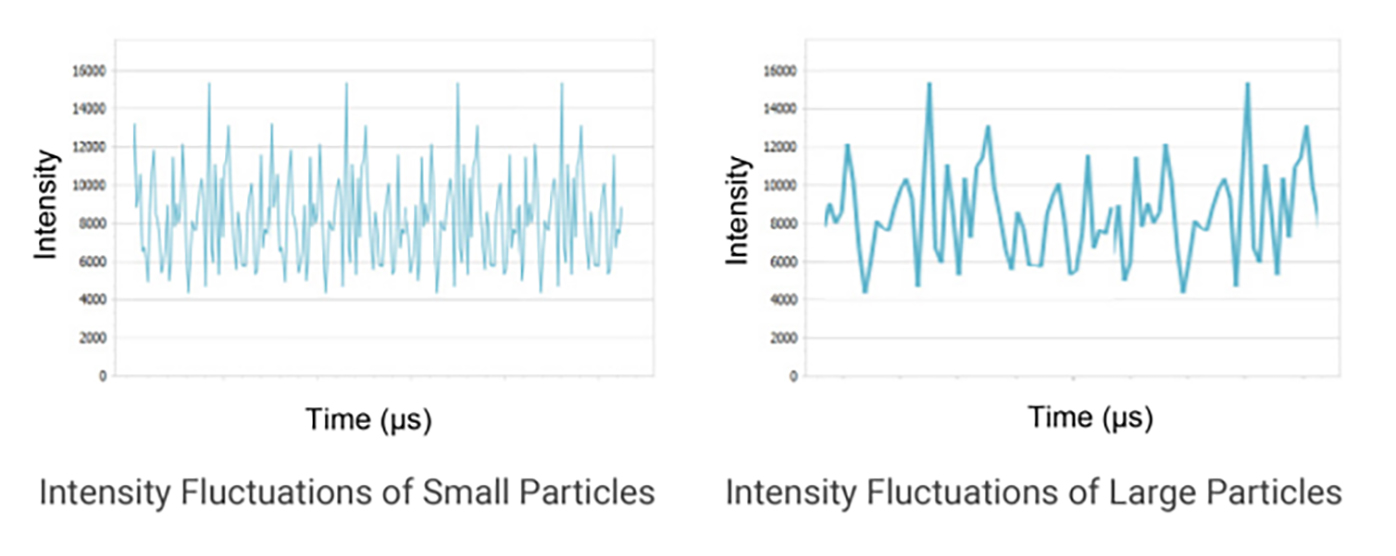
3) Backscattering Detection Technology
Features
Wider Concentration Range
By optimizing the detection position, the highly concentrated samples can be detected near the edge of the sample cell, effectively minimizing the multiple light scattering effect.Higher Sensitivity
8-10 times scattering volume and around 10 times sensitivity as compared to the traditional 90° optical design.Higher Size Upper Limit
It mitigates multiple light scattering from large particles and, to some extent, reduces the number fluctuation of large particles due to the much larger scattering volume.Better Reproducibility
The DLS backscattering technology is less influenced by dust contaminants and unevenly distributed agglomerates and provides better reproducibility.
Intelligent Search for the Optimal Detection Position
The software automatically determines the optimal detection position based on the size, concentration, and scattering ability of the sample to achieve the highest measurement accuracy and offer flexibility in detecting different types and concentrations of samples. This feature is particularly useful when dealing with a variety of samples, each with its unique scattering properties and concentrations.

4) Zeta Potential Measured by Electrophoretic Light Scattering (ELS)
In aqueous systems, charged particles are surrounded by counterions that form an inner Stern layer and an outer shear layer. Zeta potential is the electrical potential at the interface of the shear layer. A higher zeta potential indicates greater stability and less aggregation of the suspension system. Electrophoretic light scattering (ELS) measures electrophoretic mobility via Doppler shifts of scattered light, which can be used to determine the zeta potential of a sample by Henry’s equation.

5) Phase Analysis Light Scattering (PALS)
Phase analysis light scattering (PALS) is an advanced technology based on the traditional ELS technology, which has been further developed by Bettersize to measure the zeta potential and its distribution of a sample.
Features and Benefits
- Accurate measurement of samples with low electrophoretic mobility
- Effective for samples in organic solvents with low dielectric constant
- More accurate results for samples with high conductivity
- Effectively measures the zeta potential of particles whose charge approaches the isoelectric pointzeta potential distribution

6) Static Light Scattering
Static light scattering (SLS) is a technology that measures the scattering intensities, weight-average molecular weight (Mw), and second virial coefficient (A2) of the sample through the Rayleigh equation:

where c is the sample concentration, θ is the detection angle, Rθ is the Rayleigh ratio used to characterize the intensity ratio between the scattered light and the incident light at angle θ, Mw is the sample’s weight-average molecular weight, A2 is the second virial coefficient, and K is a constant related to (dn/dc)2.
During molecular weight measurements, scattering intensities of the sample at different concentrations are detected. By using the scattering intensity and Rayleigh ratio of a known standard (such as toluene), the Rayleigh ratios of samples at different concentrations are computed and plotted into a Debye plot. The molecular weight and the second virial coefficient are then obtained through the intercept and slope from the linear regression of the Debye plot.

7) Microrheology Measured by DLS
Dynamic Light Scattering Microrheology (DLS Microrheology) is an economical and efficient technique that utilizes dynamic light scattering to determine rheological properties. By analyzing the Brownian motion of colloidal tracer particles, information about the viscoelastic properties of the system, such as viscoelastic modulus, complex viscosity and creep compliance, can be obtained with the generalized Stokes-Einstein equation.

Features & Benefits
- Investigates rheological behaviors by measuring the thermally-driven motion of tracer particles within a material being studied
- Facilitates the measurement across a wide range of frequencies
- Applies low stress to tracer particles
- Requires only a microliter-scale sample volume
- Complements mechanical rheology results
- Suitable for weakly-structured samples
8) Temperature Trend Measurement
Measurement Parameters
- Size vs. Temperature
- Zeta Potential vs. Temperature
Features
- Benefit protein formulation stability study
- Accelerates real-time aging through elevated temperature simulation
Benefits
- Benefit protein formulation stability study
- Accelerates real-time aging through elevated temperature simulation
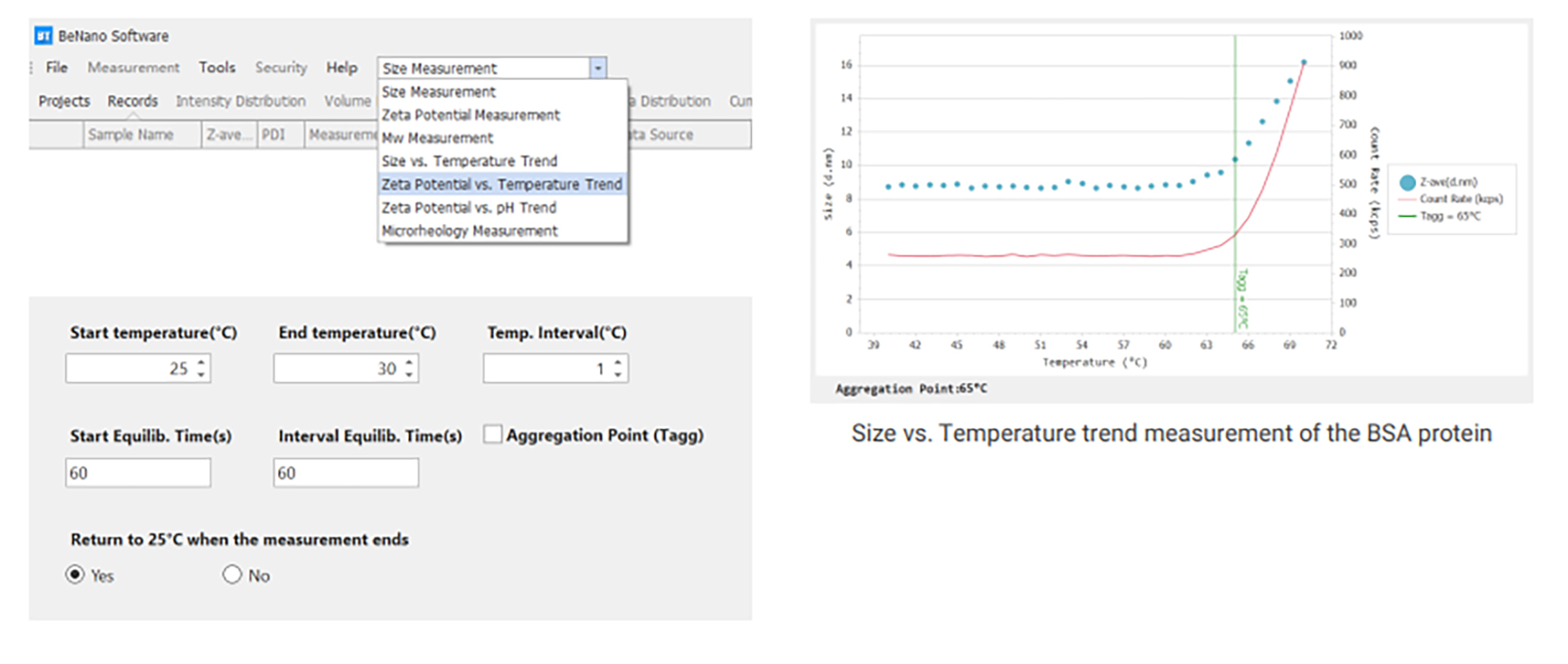
9) pH Trend Measurement
Measurement Parameters
- Zeta Potential vs. pH
- Isoelectric point
- Conductivity vs. pH
Features
- High-precision ternary titration pumps
- Controllable peristaltic pump with high flow capacity and high flow rate
- General-purpose electrode
- Automated titrant selection based on initial and target pH using intelligent software
Benefits
- Completes measurements within a shorter time
- Improves consistency and repeatability of results
- Reduces the workload of researchers
- Simplifies qualifications needed for operators
- Accelerates real-time aging through elevated temperature simulation
- Reduces exposure to corrosive liquids

10) A Research Level Software
- SOP guarantees measurement accuracy and completeness
- Automatic calculation of mean and standard deviation for results and statistics
- Comparison of results from multiple runs through statistics and overlay functions
- Real-time display of information and results
- Over 100 available parameters that meet research, QA, QC, and production needs
- Free lifelong upgrades provided

11) Compliance With FDA 21 CFR Part 11
The BeNano software system is compliant with 21 CFR Part 11 regulations, which restricts access to authorized individuals through a username and password system for electronic record signing, access logs, change logs, or operation execution. An activation code can be used to upgrade security settings and ensure compliance, and an “audit trail” can be viewed to ensure proper management and maintenance of system security and data integrity.

-
Technology

-
Accessories

BAT-1 Autotitrator
1) Introduction
The BAT-1 Autotitrator is equipped with three high-precision titration pumps (with precision of 0.28 μL), and a magnetic stirrer, and is in combination with the BeNano series nanoparticle size and zeta potential analyzer for automatic acid-base titration and determination of isoelectric point (IEP). The pinch valve can close the circuit of the sample during the measurement, leading to high efficiency, accurate titration, good repeatability and the results being independent of operators. The disposable sample container can avoid the sample cross-contamination.

2) Features
- Combination electrode with high precision and high feedback speed
- High precision ternary titration pumps
- Controllable peristaltic pump with high flow capacity and high flow rate
- Internal magnetic stirrer system
- SOP operation
- Replaceable tubes
- Corrosion resistant design
- General purpose electrode
- Intelligentization
- Determination of isoelectric point
3) How it works
The BAT-1 Autotitrator is designed to be used with the BeNano series for the measurement of zeta potential over a wide pH range, providing the information of zeta potentials and the stability of samples in different conditions. The operation flow is as follows:
- a). Preparing the samples to be detected and the titrants in the containers, respectively;
- b). Creating or editing a titration SOP in BeNano software by setting the volume of the sample to be measured, the concentrations of the titrants, the initial pH, the target pH, the pH interval and the target pH tolerance, etc.;
- c). To start the determination, the sample is titrated to approach to the first pH value through automatic calculation, and is injected into the folded capillary cell by the peristaltic pump for zeta potential measurement;
- d). Repeating the above procedures until approaching the final target pH automatically;
- Saving and outputting complete data and the trend plot of zeta potential vs. pH;
- Giving the isoelectric point if it is included in the setting pH range.
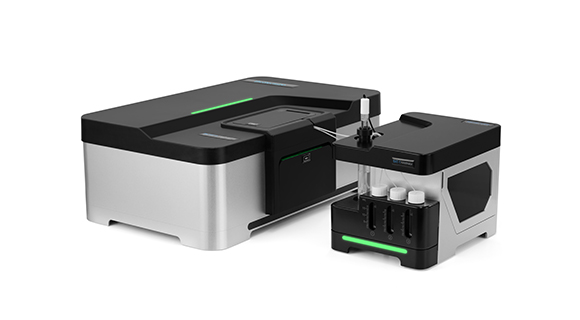
4) Download BAT-1 Autotitrator Flyer
-
Applications
-
Specification
Functions
Parameter
BeNano 180 Zeta Pro
BeNano 180 Zeta
BeNano 90 Zeta
BeNano Zeta
BeNano 180 Pro
BeNano 180
BeNano 90
Size
measurementSize
measurement range0.3 nm – 15 μm*
0.3 nm – 10 μm*
0.3 nm – 15 μm*
N/A
0.3 nm – 15 μm*
0.3 nm -10 μm*
0.3 nm – 15 μm*
Sample volume
3 μL – 1 mL*
40 μL – 1 mL*
3 μL – 1 mL*
N/A
3 μL – 1 mL*
40 μL – 1 mL*
3 μL – 1 mL*
Detection angle
90° & 173° & 12°
173° & 12°
90° & 12°
N/A
90° & 173°
173°
90°
Analysis algorithm
Cumulants, General Mode,
CONTINCumulants, General Mode,
CONTINCumulants, General Mode,
CONTINN/A
Cumulants, General Mode,
CONTINCumulants, General Mode,
CONTINCumulants, General Mode,
CONTINUpper limit of
concentration range40% w/v*
40% w/v*
Optically clear+
N/A
40% w/v*
40% w/v*
Optically clear†
Detection position
Movable position
0.4 – 5 mmMovable position
0.4 – 5 mmFixed position
5 mmN/A
Movable position
0.4 – 5 mmMovable position
0.4 – 5 mmFixed position
5 mmZeta potential
measurementDetection angle
12°
12°
12°
12°
N/A
N/A
N/A
Zeta potential
measurement rangeNo actual limitation
No actual limitation
No actual limitation
No actual limitation
N/A
N/A
N/A
Electrophoretic mobility
> ± 20 μm·cm/V·s
> ± 20 μm·cm/V·s
> ± 20 μm·cm/V·s
> ± 20 μm·cm/V·s
N/A
N/A
N/A
Conductivity
0 – 260 mS/cm
0 – 260 mS/cm
0 – 260 mS/cm
0 – 260 mS/cm
N/A
N/A
N/A
Sample volume
0.75 – 1 mL
0.75 – 1 mL
0.75 – 1 mL
0.75 – 1 mL
N/A
N/A
N/A
Sample size
2 nm – 110 μm
2 nm – 110 μm
2 nm – 110 μm
2 nm – 110 μm
N/A
N/A
N/A
Other
measurementsMolecular weight
(Mw)342 Da – 2 x 107 Da* 342 Da – 2 x 107 Da* 342 Da – 2 x 107 Da*
N/A
342 Da – 2 x 107 Da*
342 Da – 2 x 107 Da*
342 Da – 2 x 107 Da*
Viscosity
0.01 cp – 100 cp*
0.01 cp – 100 cp*
0.01 cp – 100 cp*
N/A
0.01 cp – 100 cp*
0.01 cp – 100 cp*
0.01 cp – 100 cp*
Interaction parameter
KDNo actual limitation
No actual limitation
No actual limitation
N/A
No actual limitation
No actual limitation
No actual limitation
Trend measurement
Time and temperature
Time and temperature
Time and temperature
Time and temperature
Time and temperature
Time and temperature
Time and temperature
System
parametersTemperature
control range-15℃ – 110℃,
±0.1℃-15℃ – 110℃,
±0.1℃-15℃ – 110℃,
±0.1℃-15℃ – 110℃,
±0.1℃-15℃ – 110℃,
±0.1℃-15℃ – 110℃,
±0.1℃-15℃ – 110℃,
±0.1℃Condensation control
Dry air or nitrogen
Dry air or nitrogen
Dry air or nitrogen
Dry air or nitrogen
Dry air or nitrogen
Dry air or nitrogen
Dry air or nitrogen
Laser source
50 mW Solid-state laser, 671 nm#, Class 1
50 mW Solid-state laser, 671 nm#, Class 1
50 mW Solid-state laser, 671 nm#, Class 1
50 mW Solid-state laser, 671 nm#, Class 1
50 mW Solid-state laser, 671 nm#, Class 1
50 mW Solid-state laser, 671 nm#, Class 1
50 mW Solid-state laser, 671 nm#, Class 1
Correlator
Up to 4000 channels,
1011 linear
dynamic rangeUp to 4000 channels,
1011 linear
dynamic rangeUp to 4000 channels,
1011 linear
dynamic rangeUp to 4000 channels,
1011 linear
dynamic rangeUp to 4000 channels,
1011 linear
dynamic rangeUp to 4000 channels,
1011 linear
dynamic rangeUp to 4000 channels,
1011 linear
dynamic rangeDetector
Avalanche photodiode
(APD)Avalanche photodiode
(APD)Avalanche photodiode
(APD)Avalanche photodiode
(APD)Avalanche photodiode
(APD)Avalanche photodiode
(APD)Avalanche photodiode
(APD)Intensity control
0.0001% – 100%,
manual or automatic0.0001% – 100%,
manual or automatic0.0001% – 100%,
manual or automatic0.0001% – 100%,
manual or automatic0.0001% – 100%,
manual or automatic0.0001% – 100%,
manual or automatic0.0001% – 100%,
manual or automaticDimensions
(L x W x H)62.5 x 40 x 24.5 cm
(22 kg)62.5 x 40 x 24.5 cm
(22 kg)62.5 x 40 x 24.5 cm
(22 kg)62.5 x 40 x 24.5 cm
(22 kg)62.5 x 40 x 24.5 cm
(22 kg)62.5 x 40 x 24.5 cm
(22 kg)62.5 x 40 x 24.5 cm
(22 kg)Power supply
AC 100-240 V,
50-60 Hz, 4AAC 100-240 V,
50-60 Hz, 4AAC 100-240 V,
50-60 Hz, 4AAC 100-240 V,
50-60 Hz, 4AAC 100-240 V,
50-60 Hz, 4AAC 100-240 V,
50-60 Hz, 4AAC 100-240 V,
50-60 Hz, 4AConformity
to standards21 CFR Part 11, ISO 13321, ISO 22412, ISO 13099
21 CFR Part 11, ISO 13321, ISO 22412, ISO 13099
21 CFR Part 11, ISO 13321, ISO 22412, ISO 13099
21 CFR Part 11, ISO 13321, ISO 22412, ISO 13099
21 CFR Part 11, ISO 13321, ISO 22412, ISO 13099
21 CFR Part 11, ISO 13321, ISO 22412, ISO 13099
21 CFR Part 11, ISO 13321, ISO 22412, ISO 13099
Optional Accessories
Disposable
micro-volume cuvette40 – 50 μL
40 – 50 μL
40 – 50 μL
N/A
40 – 50 μL
40 – 50 μL
40 – 50 μL
Micro-volume
glass cuvette25 μL
N/A
25 μL
N/A
25 μL
N/A
25 μL
Glass cuvette
with round opening1 mL
1 mL
1 mL
N/A
1 mL
1 mL
1 mL
Capillary sizing cell
3 – 5 μL
N/A
3 – 5 μL
N/A
3 – 5 μL
N/A
3 – 5 μL
Dip cell kit
1 – 1.5 mL,
zeta potential measurement
for organic-based samples1 – 1.5 mL,
zeta potential measurement
for organic-based samples1 – 1.5 mL,
zeta potential measurement
for organic-based samples1 – 1.5 mL,
zeta potential measurement
for organic-based samplesN/A
N/A
N/A
* Dependent on samples and accessories
† Up to 40% w/v using capillary sizing cell
# 10mW 633nm He-Ne laser available on request
Not sure if it’s the right instrument?
No worries, send us a sample and we will test it for you
Send a sample-
Outstanding service

I have been using Meritics for a number of years and they always provide outstanding service and support.
They have a rapid response turnarounds and are very knowledgeable of the techniques and products they provide.LeanneB-375
-
Good service, very helpful

We use Meritics for the PM service and installation of all our FlowCams . Megan has been coming to our site for a number of years. She is very efficient in her work, but most of all Megan is very helpful. We have had issues with one of instruments after the install and Megan did her utmost to try and solve it while on site, even though it wasn’t solved Megan has been in contact with the supplier of the instrument to try and solve this problem for us.
SophieH-2201
-
Job done in a friendly manner

Booking engineer visits is always easy. David Lowe, Meritics engineer is always very friendly.
ThierryN
-
Service/calibration visit

Excellent service, arrived on time, polite, friendly and informative.
NathamM-270
-
5 Stars

Excellent service from an excellent company. Would recommend them to anyone.
BarryH-480
-
Good Service

David, our service engineer as usual was good at communicating and setting up the recent service appointment, he arrived on time, did the service promptly and informed me of any problems. Friendly and helpful
TomA-446
-
Superb and prompt service

I have used this company through the laboratory I work for frequently. We specialise in soil analysis, and Meritics were chosen as they have extensive knowledge of the instruments we use. We have several laser particle diffraction analysers with a service contract, and service is always very prompt and meticulous….
JamesG-2483
-
Good experience over two years

Meritics have covered the annual servicing of our Multisizer 4e instrument since we purchased it from them just over two years ago. The application scientist who performed the servicing was friendly, knowledgeable, and extremely helpful, happily answering a barrage of questions about how best to use and maintain the instrument. All my interactions with Meritics staff have been positive. I would happily recommend them.
RajG-62
-
Fully committed to customer service

Service second to none, both units serviced and all questions answers by engineer while on site.
RichardA-786
-
Highly recommend Meritics for equipment purchases and aftercare services

After owning one of our instruments for over 8 Years which was purchased from Meritics, it suffered its first breakdown. Upon contacting Meritics, I was instantly put through to an engineer who was very helpful. Upon inspection of the manual, it was decided that it would be more cost effective to have a Meritics engineer visit. The Meritics staff were very communicative and kept me up to date.
-
Excellent Service

Lovely, friendly and extremely helpful. David and his team are always on call with advise and are very easy to work with and are always happy to help.
NaomiT-64
-
Service of lab equipment

Excellent service. Friendly and professional service was provided in a timely manner to the expected standard.
NathanM-270
-
Excellent

Excellent communication. Updates given well in advance. Very polite staff and engineers.
NathanM-270
-
Multisizer 4e install at pharmaceutical company

2 people helped with the install of a Multisizer 4e. They were both very professional and friendly, answering any questions that I had. The installation was quick and the attention to good documentation practice was exceptional.
Chloel-9
-
Service of Beckman Coulter instruments

Always a pleasure to welcome the Meritics service engineer, who is knowledgeable, personable and extremely competent.
NeilT-394
-
Professional

Friendly and collaborative staff, provided a very good service.
SamK-403
-
Professional, Customer-oriented, fast service

We had issues with one of the aperture tubes provided by Meritics on a Friday afternoon, while very pressed for a review deadline. Meritics handled our inquiries very fast and professionally and helped us out by shipping us their spare tube to use in the mean time free of charge, while we waited for our new tube to arrive. Communication was very pleasant.
VeerleB
-
Very helpful and prompt

I emailed for some technical help and also to get some spares and both the engineer (David) and purchasing (Sophie) were very prompt to respond and helpful. We do have a service contract but I appreciated being able to email the engineer directly.
AlexH-474
-
Excellent Service

Used Meritics to conduct particle size distribution by laser diffraction. Service as last time, is very quick, well priced and professional.
I would highly recommend
GavinR-101
-
Excellent and Friendly Service

Always a pleasure to deal with the people at Meritics Ltd. They understand the importance of our work and the fact that our research projects have deadlines that need to be met. Consequently, problems are dealt with very quickly and professionally and they are willing to go that one step further to make sure their supply chain problems don’t become our problems. Thank you to the team for their support. It is greatly appreciated.
JanetH-255





